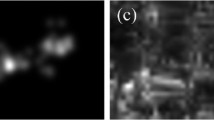Abstract
We address the statistical inference of saliency features in the images based on human eye-tracking measurements. Training videos were recorded by a head-mounted wearable eye-tracker device, where the position of the eye fixation relative to the recorded image was annotated. From the same video records, artificial saliency points (SIFT) were measured by computer vision algorithms which were clustered to describe the images with a manageable amount of descriptors. The measured human eye-tracking (fixation pattern) and the estimated saliency points are fused in a statistical model, where the eye-tracking supports us with transition probabilities among the possible image feature points. This HVS-based statistical model results in the estimation of possible tracking paths and region of interest areas of the human vision. The proposed method may help in image saliency analysis, better compression of region of interest areas and in the development of more efficient human-computer-interaction devices.
Access this chapter
Tax calculation will be finalised at checkout
Purchases are for personal use only
Preview
Unable to display preview. Download preview PDF.
Similar content being viewed by others
References
Arrington Research, GigE-60 head-mounted eye-tracker, http://www.arringtonresearch.com/LaptopEyeTracker1.html
Arrington Research, GigE-60 head-mounted eye-tracker (image), http://www.arringtonresearch.com/news.html
iView X Hi-Speed eye-tracker, http://www.smivision.com/en/gaze-and-eye-tracking-systems/products/iview-x-hi-speed.htm
MIT Street Scene Database (2007), http://cbcl.mit.edu/software-datasets/streetscenes/
Ground Truth Database (2009), http://www.cs.washington.edu/research/imagedatabase/
Avraham, T., Lindenbaum, M.: Esaliency (extended saliency): Meaningful attention using stochastic image modeling. IEEE Transactions on Pattern Analysis and Machine Intelligence 32, 693–708 (2010)
Banko, E.M., Gal, V., Kortvelyes, J., Kovacs, G., Vidnyanszky, Z.: Dissociating the effect of noise on sensory processing and overall decision difficulty. Journal of Neuroscience 31(7), 2663–2674 (2011)
Betz, T., Kietzmann, T.C., Wilming, N., Konig, P.: Investigating task-dependent top-down effects on overt visual attention. Journal of vision 10(3) (2010)
Csurka, G., Dance, C., Fan, L., Willamowski, J., Bray, C.: Visual categorization with bags of keypoints (2004)
Harel, J., Koch, C., Perona, P.: Graph-based visual saliency. In: Advances in Neural Information Processing Systems 19, pp. 545–552. MIT Press (2007)
Itti, L., Koch, C., Niebur, E.: A model of saliency-based visual attention for rapid scene analysis. IEEE Trans. Pattern Analysis and Machine Intelligence 20(11), 1254–1259 (1998)
Liu, T., Yuan, Z., Sun, J., Wang, J., Zheng, N., Tang, X., Shum, H.Y.: Learning to detect a salient object. IEEE Transactions on Pattern Analysis and Machine Intelligence 33, 353–367 (2011)
Lowe, D.G.: Distinctive Image Features from Scale-Invariant Keypoints. International Journal of Computer Vision 60, 91–110 (2004)
Nyström, M., Holmqvist, K.: An adaptive algorithm for fixation, saccade, and glissade detection in eyetracking data. Behavior Research Methods 42, 188–204 (2010)
Sivic, J., Zisserman, A.: Video google: a text retrieval approach to object matching in videos. In: Ninth IEEE International Conference on Computer Vision, vol. 2, pp. 1470–1477 (2003)
Smith, K., Ba, S., Odobez, J.M., Gatica-Perez, D.: Tracking the Visual Focus of Attention for a Varying Number of Wandering People. IEEE Transactions on Pattern Analysis and Machine Intelligence 30(7), 1212–1229 (2008)
Szolgay, D., Benedek, C., Sziranyi, T.: Fast template matching for measuring visit frequencies of dynamic web advertisements. In: International Conference on Computer Vision Theory and Applications (VISAPP), Porto, Portugal (2008)
Tseng, P.H.H., Carmi, R., Cameron, I.G., Munoz, D.P., Itti, L.: Quantifying center bias of observers in free viewing of dynamic natural scenes. Journal of vision 9(7) (2009)
Author information
Authors and Affiliations
Editor information
Editors and Affiliations
Rights and permissions
Copyright information
© 2012 Springer-Verlag Berlin Heidelberg
About this paper
Cite this paper
Szalai, S., Szirányi, T., Vidnyanszky, Z. (2012). Tracking the Saliency Features in Images Based on Human Observation Statistics. In: Salerno, E., Çetin, A.E., Salvetti, O. (eds) Computational Intelligence for Multimedia Understanding. MUSCLE 2011. Lecture Notes in Computer Science, vol 7252. Springer, Berlin, Heidelberg. https://doi.org/10.1007/978-3-642-32436-9_19
Download citation
DOI: https://doi.org/10.1007/978-3-642-32436-9_19
Publisher Name: Springer, Berlin, Heidelberg
Print ISBN: 978-3-642-32435-2
Online ISBN: 978-3-642-32436-9
eBook Packages: Computer ScienceComputer Science (R0)




